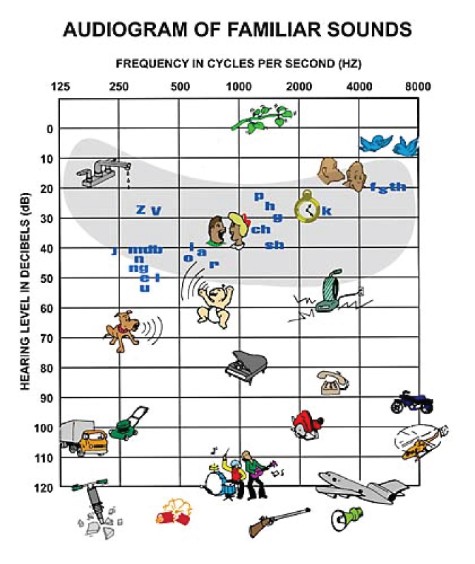UNDERSTANDING THE EAR The ear is made up of three divisions: the outer ear, the middle ear, and the inner ear. The outer ear funnels sounds from the environment and sends those signals down the ear canal toward the middle ear. Within the middle ear, your eardrum and three tiny bones (malleus, incus, & stapes) pick up those sound waves, change them into physical movements of the eardrum and bones themselves, and pass the information along to the inner ear. In here, the cochlea receives the sound information and activates the auditory nerve, which ultimately sends the sound to the brain. The brain is ultimately responsible for allowing us to hear the sounds happening all around us. |  |
 | THE AUDIOGRAM An audiogram is a graphical representation of your child's (or your own) hearing ability. The horizontal axis shows frequency, or pitch (how high or low the sound is) and the vertical axis shows hearing level, how loud or how soft a sound must be for your child to hear it. The lower the symbols appear on your child's audiogram, the more difficult it is for him or her to hear sounds at those particular pitches. |
WHAT CAN MY CHILD HEAR? Sometimes it is helpful to put complicated scientific charts into simpler terms. This audiogram tries to do just that. It shows what types of sounds naturally occur at certain pitches and certain loudness levels. You are probably familiar with most, if not all, of these sounds. As you can see, the sounds made during speech (such as 'zzz' 'ch' 'mmm') are usually no louder than 50-60 dB HL. Using this guide, along with your child's audiogram given to you by your audiologist, you can get a general idea of what your son or daughter is still able to hear. |  |
Portions of this information came from: Bell, T. S. & Williams, T. L. (2008). Anatomy and physiology of the ear. In Peterson, M. E. & Bell, T. S., Foundations of Audiology: A Practical Approach (pp. 47-67). Upper Saddle River, NJ: Pearson.